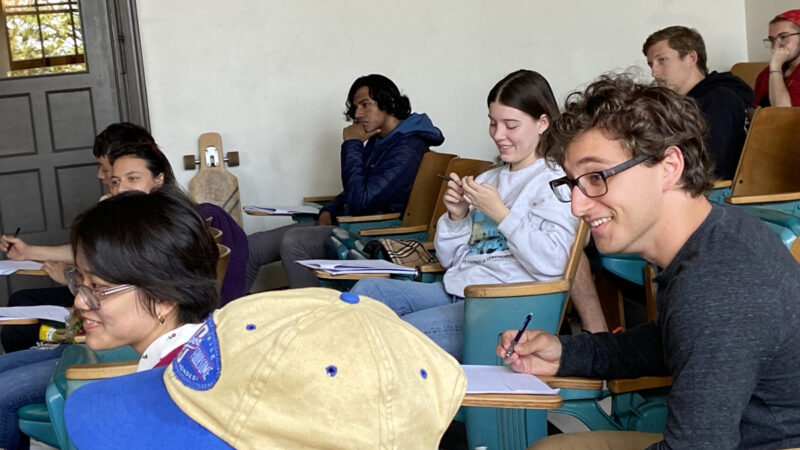Inspiration for writing a scene, or a play, can come from anywhere. Playwrights often make use of archival material and at USC, USC Libraries is fortunate to include ONE Archives, the largest repository of LGBTQ materials in the world, which is a treasure trove of undiscovered stories just waiting to be turned into dramatic works.
In early April, Oliver Mayer, professor of dramatic writing, took his undergraduate playwriting students on a field trip to the archives, and gave them a writing prompt utilizing an unusual photo collection there. Then, during the last week of classes, he arranged for MFA acting alums to do readings of the scenes the students wrote.
The photo collection is 18 small format black and white images of a gay wedding held in a home or apartment in Philadelphia in the 1950s. No one is identified in the photos and the wedding couple never saw the images, as the owner of the photo shop where the film was developed confiscated them. The daughter of the photo shop owner was selling the images online, and a ONE Archives donor bought them and gave them to the archives in 2012.

Michael Oliveira, a librarian who gave the SDA class a tour at the archives, located north of campus at 909 West Adams Boulevard, said the images present “so many unanswered questions.” All the window blinds in the photos are closed, he noted, and one man standing in the kitchen seems to be in distress. Another man is in drag, and it’s unclear whether he’s part of the wedding photos or not. “This wedding could have happened anywhere, and there’s so much you could imagine,” he said.
ONE Archives became part of USC Libraries in 2010, and Oliveira said that USC professors are increasingly making use of its letters, photographs, books, artwork and exhibitions in their classes. “We’ve had writing classes, library classes and history classes coming to see what’s here,” he said. Oliveira said he gave Mayer, who heads SDA’s undergraduate and MFA playwriting programs, a half dozen other ideas of material in the archives he might want to use for future classes.
Surprisingly, none of the 15 students in the class, many who were juniors and seniors, had visited ONE Archives before. Many were unaware it existed.
Some of the scenes the students wrote focused on the emotions of the men getting married, while others used the images as a jumping off point. Jonathan Pelster, a senior BA theatre major, learned from the archives trip that there was a strong connection between science fiction fandom and gay culture in Southern California, and his scene, “Qualon,” included that.
Cameryn Baker, a senior creative writing major at USC Dornsife, included in her scene reference to a character not shown in the images – a woman that one of the grooms was planning to marry as a way to hide his homosexuality from the world.
Some scenes had flashes of humorous dialogue, one included some shocking history of the grandfather of one of the grooms, and many referred to the clandestine nature of the ceremony via the shuttered blinds. “We’re risking our lives for our make-believe contract,” said one character. “We could go to prison.”

Actors Jered Hobbs MFA ’13 and Goran Ivanovski MFA ’18 read the scenes with great skill, helped out by Mayer who read stage directions and played additional characters as needed. On the first day scenes were performed, Lea Lanoue MFA ’20 performed with Hobbs and Ivanovski.
Hobbs called the writing in the scenes “kind of profound,” and both he and Ivanovski called on a full range of emotions to do justice to the words, depicting characters who were by turns scared, tearful, angry, jealous, witty or reflective.
Mayer was thrilled with the results. “It has been a wonderful exercise that has really focused the compassion and observational skills of the writers,” he said.
The project already has inspired one student to create his own collaboration with ONE Archives. Zack Rocklin-Waltch, a junior BFA acting student, asked librarian Oliveira if he could do a reading of a play he wrote, The Fire at the Edge of the Earth, at the archives. Oliveira and the archives agreed, and a reading with an audience of about 40, was held there April 18. The two-character play, produced by Wendy Hui, a ’21 design BFA, is headed for the Edinburgh Fringe Festival in August. “The play deals with queer love and existence and the archives seemed like the perfect place,” said Rocklin-Waltch. “And the people at the archives were so gracious and open to doing it there.”
Rocklin-Waltch said his class visit to the archives was emotional. “Learning about the local queer history in L.A. and the different ways queer people have fought to be represented and respected brought me to tears just being there.” The ripple effect of the archives visit is continuing, Rocklin-Waltch said. “I’ve been telling my friends about the archives, and now one friend is applying for an internship there.”
